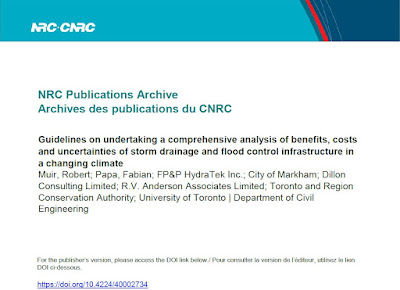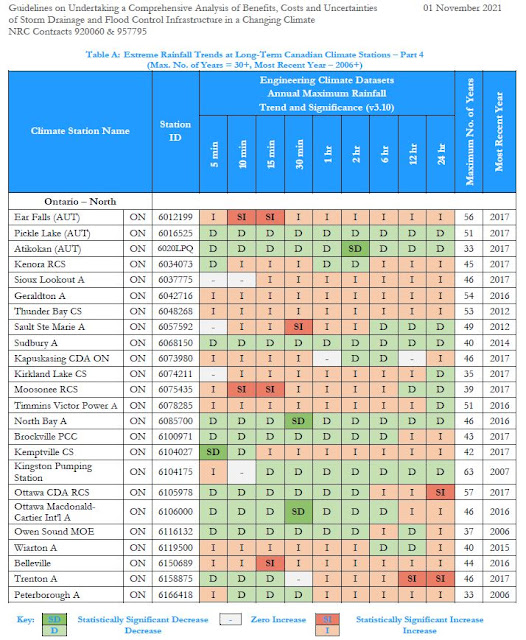The full guidelines are available here to download: https://nrc-publications.canada.ca/eng/view/object/?id=27058e87-e928-4151-8946-b9e08b44d8f7
These guidelines delve into many topics to support comprehensive benefit cost analysis. As the effects of a changing climate on flood damages (and adaptation benefits of reducing them) are considered, trends in extreme rainfall across Canada are reviewed in the foundation research. The review shows that on average extreme rainfall intensities have not increased when the most recently observed data is considered.
Extreme rainfall intensities can be characterized by the high return period values in Intensity-Duration-Frequency (IDF) statistics. For example the 100-year rainfall intensity would be the rate of rainfall over a range of durations that has a 1% chance (i.e., 1/100) of occurring in a single year, based on the statistical analysis of past observations. Similarly 50-year storm rainfall rates have a 2% change of occurring during any year (i.e., 1/50), 25-year rainfall has a 4% chance, 10-year has a 10% chance, etc..
The guidelines present the following table showing 2-year to 100-year design rainfall intensity trends at 226 climate stations across Canada for durations of 5 minutes to 24 hours (Appendix E, Table 17):
As shown, 100-year storm intensities have decreased on average by 0.5% from the v2.00 to the v3.10 Engineering Climate Datasets. On average the derived 10-year to 50-year rainfall rates have decreased as well.
IDF intensity values are derived from observed annual maximum rainfall values, called an annual maximum series (AMS). One can look at the trends in AMS values to understand how derived 'return period' intensities are changing over time. The NRC guidelines summarized Environment and Climate Change Canada's analysis of these trends across Canada in the following table (Appendix E, Table 11):
The table counts instances where observed rainfall has decreased significantly (i.e., a statistically strong trend), has decreased (a weaker trend), has not changed, has increased (a weak trend), or has increased significantly (a strong trend). Across Canada the totals show decreasing trends in 131+2235=2366 data points and increasing trends in 2526+251=2777 data points. And 266 data points showed no change. This summary indicates that both decreases and increases are occurring, with slightly more increases.
The NRC guidelines present additional analysis of more regional trends as well. This can help practitioners understand recent changes in extreme rainfall affecting local flood damages. For example the AMS trends in southern and northern Ontario are presented in the following two tables (Appendix E, Annex E1, Table A Part 3 & Part 4):
Ontario is shown to have increasing and decreasing AMS values (i.e., annual maximum observed rainfall) that varies by location (climate station) and duration. In some cases annual maximum rainfall is decreasing/unchanged or increasing/unchanged for all durations while in others short duration values have increased while long duration values have decreased - or vise versa. For example:
Stations with all decreasing/unchanged trends for all durations:
- Elora RCS
- Hamilton A
- Toronto City
- Toronto North York
- Sioux Lookouk
- Geralton A
- Thunderbay CS
- Belleville
Overall 2-year rainfall intensities, representing smaller storm severity, have decreased. Meanhile 100-year intensities have increased and decreased. This analysis aggregates all durations. Given the variability from station to station shown earlier (e.g., Toronto City has decreasing trends while Toronto North York has increasing trends, trends in long and short durations are inconsistent at individual stations), there is a benefit in aggregating larger sets of data (across durations and geography) to estimate overall regional trends.






